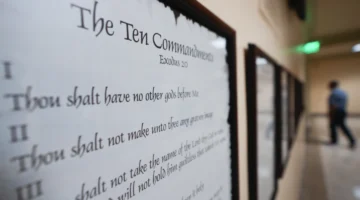Construction Completed on Six Canal Restoration Demonstration Projects; Monitoring Underway With Early Results Showing Improved Water Quality
Monroe County just completed an air curtain installation that blocks weeds from entering Big Pine Key’s Canal #287, one of the Keys’ 131 poor-rated canals. This marks the end of the construction phase of the County’s original $5-million investment in demonstration projects that implemented four different restoration methods – air curtain weed gate installation, organic muck removal, culvert installation and backfilling– to restore six of the worst water quality canals in unincorporated Monroe County.
Water quality monitoring is underway to scientifically evaluate the results of each demonstration restoration. The three-year program, conducted by Florida International University and funded by the United States Environmental Protection Agency, included one year of monitoring prior to construction to set a baseline and two years of monitoring following the completed restoration to determine the success rate.
The initial post-construction monitoring results are promising. They show improved dissolved oxygen levels and clarity, as well as an increase in sea life.
“We are pleased that the early results show the restored canals are helping to bring back marine life,” Monroe County Sustainability Director Rhonda Haag said. “We already have learned much from each type of project and still have more demo projects to complete to test new methods. It is a massive undertaking to clean up all the canals in the Keys that don’t meet the state minimum standards of water quality, and these demo projects will help us determine the most cost effective way to do so.”
Canal restoration became a priority for the County after a study completed in 2013 by Amec Foster Wheeler Florida found that 311 of the 502 canals throughout the island chain do not meet the State’s minimum water quality criteria and are a potential source of nutrients and other contaminants to near shore waters. Of the 311 impaired canals, 131 of them were rated poor.
“For 18 years as a Monroe County Commissioner, not a work day has gone by without discussing and dealing with water quality – whether dealing with the central collection of waste water and treatment, storm water runoff, and now, degraded water quality in the hundreds of canals that crisscross our county,” Monroe County Commissioner George Neugent said. “The threat is real to our near shore waters, the same waters that drive our tourist-based economy. And due to the growing popularity of the island chain, we are loving our Keys to death.”
The county of just 77,000 residents – at a combined cost of nearly $1 billion to government, homeowners and business owners – already has built several new wastewater systems to eliminate sewage from going into the ground and continuing to contaminate the near shore waters.
While the new wastewater systems have improved water quality in the Keys, they do not address the root cause of impaired, man-made canals that have little to no dissolved oxygen. These root causes: years of accumulated seaweed, canals dug too deep, little to no circulation and dead end canals.
The Canal Restoration program began in 2012, when Monroe County was awarded grants from the Florida Department of Environmental Protection and the U.S. Environmental Protection Agency to complete a Canal Management Master Plan. After extensive fieldwork, the plan was completed in 2014, with the Board of County Commissioners approving a $5 million series of canal restoration demonstration projects using infrastructure sales tax funds.
In 2016, an additional $2 million was added to the canal restoration demonstration projects. This money, which also comes from the infrastructure sales tax, will be for projects using additional techniques: a combination organic muck removal /backfilling project and in-place aeration techniques.
The County is awaiting receipt of $450,000 in Gulf Coast Restoration Trust funds that were approved by the RESTORE committee to be used for canal restoration projects. (The fund is from the settlement of the 2010 Deepwater Horizon oil spill). The County also is anticipating some water quality funds to be approved and received from the State under the new Florida Keys Stewardship Bill.
“The County thanks the EPA and the Florida Department of Environmental Protection for their continued support through annual grants the past four years,” Haag said. “These grants spearheaded the beginning of the program, and have continued to help maintain the momentum of moving forward with restoration activities.”
Here’s a look at the six completed restoration projects and the early results. The costs include engineering designs, construction and outreach services.
First project: Backfilling at Canal #29 in Sexton Cove in Key Largo was completed in July 2015. Nine hundred truckloads of clean fill were used to raise the canal’s depth from 35 feet to 8 feet, followed by a 6-inch layer of sand capping Immediately upon completion, a return of abundant sea life was noted by canal residents. Monitoring has found a revegetation of the canal bottom has begun. Cost: $1.36 million.
Second project: Culvert Installation to connect two canals, #470 and #472, on Geiger Key was completed in April 2015. This project involved installing a 112-foot, 24- by 38-inch culvert to enhance natural tidal flushing. FIU’s water quality researchers found a dramatic jump in the water quality, immediately going from poor to good. But by late May, heavy seaweed build up in the canal caused some homeowners to believe the culvert was the problem. The culvert was plugged in July 2015. After an extensive engineering evaluation, the culvert was unplugged in May 2016 and is now being carefully monitored. $221,000 ($100,000 paid for state DEP)
Third project: Combined Organic Removal and Air Curtain Installation on Canal #266 at Drs. Arm and Avenue J in Big Pine Key was completed in May 2016. Vacuum dredging removed 5 feet of decayed seaweed and muck from this canal and 16 – 10 cubic yard trash containers, one of the very worst in the entire County. Mechanical dewatering allowed local reuse of the dredged material, thus providing for a sustainable use of the material. Following removal of the muck, a 6-inch sand layer was added to allow for benthic habitat proliferation. An air curtain weed gate was installed at the mouth of the canal to keep out additional weed wrack. An air curtain is a barrier of air bubbles that are pumped from devices placed at the bottom. The County will provide 2 years of operation and maintenance for the system. There was immediate elimination of the hydrogen sulfide odor, improved clarity and increased oxygen levels. $1.35 million
Fourth project: Another Organic Muck Removal Project on Canal #290 Avenue I on Big Pine Key was completed in March 2016. The same vacuum dredging process as Canal #266 was used to remove 5 feet of decayed seaweed and muck. Following removal of the muck, a 6-inch sand layer was added to allow for benthic habitat proliferation. An existing air curtain weed gate owned by the homeowners was reinstalled, but due to unforeseen issues the weed gate has allowed some seaweed to enter the canal. The County is working with the homeowners to come up with a solution for the weed gate. Cost: $798,000
Fifth project: Installation of a 200-foot long, 60-inch in diameter culvert under a roadway and private property connected two portions of Canal #277 in Tropical Bay Estates on Big Pine Key was completed in May. This project, partially funded by the Florida Department of Environmental Protection, improves natural tidal flushing. Water clarity has improved, with fish visible at the entrance to the culvert. Cost: $424,000 ($50,000 paid by state DEP)
Sixth project: Air Curtain Weed Gate Installation for #287 in Atlantic Estates on Big Pine Key was completed last week. With this project, unlike Canal #266, there was no organic removal first. This project also removed an old, unpermitted physical weed barrier. The County will provide 2 years of operation and maintenance for the system. Cost: $150,000.
To help determine the next steps for dealing with the massive problem of restoring all the impaired canals to water quality that meets the State’s minimum standards, the Board of County Commissioners held a canal restoration workshop in April. The workshop discussed the following items: municipality support and participation, regulatory requirements, funding sources, resident participation, the successes of the completed demonstration projects and the issues identified during the demonstration projects.
For more information about FIU’s monitoring of the demonstration projects, go to http://seagrass.fiu.edu/canals/ and http://serc.fiu.edu/wqmnetwork/Canals/index.htm.
[livemarket market_name="KONK Life LiveMarket" limit=3 category=“” show_signup=0 show_more=0]



No Comment